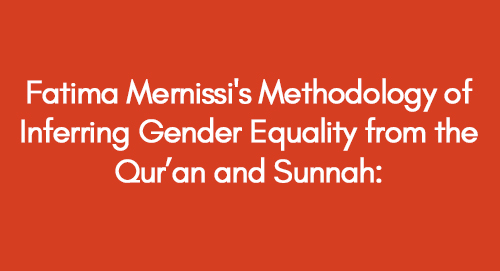
Impact of Playing Extensive Video Games on Young Adults with Autism Spectrum Disorders
June 16, 2022
Adult Community Nursing: Public Health in Action
June 16, 2022Fatima Mernissi's way of looking at gender equality in Islam by studying the Qur'an and Sunnah is interesting. She tries to find where women and men can be more equal in Islamic teachings. Her approach has started important discussions about this.
The following text comprises the study's introduction.
Introduction
An unresolved debate exists around the methodology that Islamic feminism follows when interpreting sacred Islamic texts. While secular feminists claim that Islamic feminism is defensive and apologetic, orthodox Muslim scholars adhere to traditional interpretations of the Qur'an and Sunnah, claiming that Islamic feminists give misleading readings of Islamic sacred texts (Ahmed-Ghosh, 2008). Moroccan writer and sociologist Fatima Mernissi is one of the most prominent Islamic feminists.
Comparison Between Islam and Christianity in Influencing the Gender Role of Women
In her writings, she has presented unconventional interpretations of the Qur'an and Sunnah and the biography of the Prophet Muhammad, promoting equality between men and women in Islam. She has also criticized the social and political conditions that women experience in Morocco and the Arab countries (Malik, 2014).
This qualitative research presents a new approach to criticizing Mernissi's method of inferring gender equality in Islam from the Qur’an and Sunnah. This research aims to assess the extent to which Fatima Mernissi was defensive and apologetic when reinterpreting the Islamic sacred texts. This will be done by examining the inconsistencies in her methodology. This research is ambitious, as this new approach could be employed to criticize more Islamic feminist writings, thereby contributing to the general criticism of Islamic feminism. It could also be used to test the validity and accuracy of Islamic feminist interpretations and traditional orthodox readings.
Problem Statement
Criticisms of Islamic feminists, including Mernissi’s writings, are critiques of their interpretation of specific Quranic verses and Hadiths. These critiques are old orthodox readings or repeated presentations of Islamic texts, which are believed to support the notion of patriarchy and inequalities between men and women. Hence, a new methodology of criticism is needed to reduce the ambiguity around the accuracy and validity of Mernissi's readings of sacred Islamic texts and to assess the extent to which she was apologetic.
Research Aim
To critically analyze Fatima Mernissi's methodology of inferring gender equality from the Qur’an and Sunnah.
Research Objectives
To evaluate methodological principles derived from the arguments of Fatima Mernissi.
To examine the inconsistencies of Mernissi’s methodological principles by tracking their applications in Quranic verses and Sunnah texts that relate to women.
Literature Review
Learn from what others have written about Islamic Feminism below;
Islamic Feminism
Research by Kynsilehto (2008) presented the concepts of Islamic feminism and stated that the context of Islamic orthodoxy and the closed structures of the project to modernity in the Arab world Islamic feminism is said to be contributing toward enriched human cultural diversity and the development of locally grounded discursive experience. Moreover, women scholars often tend to review the Islamic tradition from the context of Islamic texts and advocate the point of view where gender egalitarianism is fully embedded, whereas, in this aspect, patriarchy is considered a legacy of dogmatism and is deemed a cultural heresy.
Find out Quality Feminism Dissertation Topics
According to Elboubekri (2015), the expansion of Islamic feminism challenges masculinized and politicized Islamic orthodoxy, interrogating the biased liberty celebrated by capitalism and modernity. Moreover, in both versions of modernity and capitalism, Islam is viewed as compatible with gender equality. In the writings of Islamic feminists, rather than taking a sacred legacy of Islam, they presented that Islam provides a system whereby men execute power, which is endorsed by the law, language, class, and nation (Seedat, 2013). One of these Islamic feminists is Najat El Hashmi, as she presented misogyny and patriarchy as a cross-cultural phenomenon of Islam. However, on the other hand, Fatima Mernissi challenged the gendered separatism within the tradition of patriarchy where male power is served (Kynsilehto, 2008). A strong confirmation by Mernissi was presented in one of the writings that in the modern world, Muslim women can walk with full pride, knowing that the quest for human rights, democracy, and dignity does not stem from any imported values rather; it is the true part of the Muslim tradition (Mernissi, 1987; Malik, 2014).
Moreover, according to Seedat (2013), Islamic feminism is not simply the one that is born in the Muslim culture. It is the one that engages Islamic theology with the canonical traditions and through the text. At its core, distinctive Islamic feminism draws the equality concept of all human beings based on Quran concepts and its application in everyday life.
Islamic Feminism and Fatima Mernissi
Western feminism has been challenged and modified from the third-world feminists’ perspectives. According to Malik (2014), third-world feminism is complex and differentiated from its region and class. Scholars treat third-world feminism with Islamic feminism or Arab feminism. One of the Arab feminists who is well known for her voice in third-world Islamic feminism is Fatima Mernissi. She is known to represent Islamic feminism by studying the issues of orientalist representation, colonial occupation, identity politics, and tolerance of feminist thoughts (Malik, 2014). Fatima Mernissi, a Moroccan from birth, the primary concern was to present the right position of women in the rapidly changing Muslim communities of the Arab World. In her first book, Beyond the Veil, she wrote about the female dynamic in modern Muslim society and highlighted the significant issues in feminist thoughts. She was the one who initially challenged Western feminism and the stereotypes of the West about Islam. Moreover, the article of Malik (2014) states that Fatima Mernissi served Arab women by shaping their lives from Islamic concepts and presenting the cognitive elements of misinterpreted Western representations of Islam.
In the words of Elboubekri (2015), it is highlighted that Mernissi presented Islamic feminism keeping the honour of the message presented in the Quran, and on this basis, the ontological equality is well described, reclaimed and emphasized for individual and social well-being. In the writings of Mernissi, the kernel of the Muslim provides democratic glorification of an individual irrespective of status, race, or sex. Furthermore, as stated in the research of Seedat (2013), scholars such as Amina Wadud, Leila Ahmed, and Fatima Mernissi presented a new trajectory to implicate the early Muslim societies to highlight the contemporary Muslim practice and reflect them in terms of Islamic feminism in the decline of the status of Muslim women. Islamic feminism is an analytical construct that presents feminism and equality of genders in a different context than the existing European intellectual heritage, where ideas and traditions are translated among the geographic, intellectual, and cultural spaces.
Methodological Principles Derived from the Arguments of Fatima Mernissi
Mernissi has never missed a chance to illustrate how the practices accredited to the Prophet are misappropriated and how political, financial, and religious establishments have skewed the actual disparities between men and women, particularly women's empowerment supporters and traditionalist Muslim adversaries. Her earlier publications have been interpreted as rejecting Islamic teachings and/or promulgating secular agendas (Mernissi, 1991). Early on in her work, she conversely noted, contradictory to what is generally believed, that Islam does not promote the argument for the intrinsic oppression of women (Mernissi, 1987). Mernissi foregrounds some verses regarding gender equality she emphasized in the Qur’an to present the Islamic views and to support or contradict the modern jargon of feminists by presenting the Prophet’s sayings and practices (Seedat, 2013). In Islam and Democracy, authored by Mernissi, a complex process of Islamic symbolism is presented to subvert the democratic aspirations of women's rights. One of the concepts of Mernissi is feminist theology, which explains the idea of women’s empowerment from the concepts of Islam by highlighting the elaboration of the faith of the wives of Prophet Muhammad (Elboubekri, 2015). Moreover, in Women and Islam, an influential book by Mernissi, the role of women in the spread of Islam was presented to discuss women's rights and the role of women played by women equally as men in spreading Islam. The power and agency of Muslim women were described, and it was also stated that women in the Islamic world also exercised political authority (Elboubekri, 2015).
Within the realm of the "pseudo-feminist" perspective, Mernissi presents a contrasting viewpoint, asserting that Islam inherently lays the groundwork for equal rights between women and men. However, some individuals may interpret her stance as pseudo-feminist due to her vocal criticism of male figures responsible for conservative Muslim institutions. Her ideas might be deemed liberal and even anti-Islamic by certain quarters. Mernissi consistently emphasizes that achieving liberation for Muslim women need not be overly complex and does not necessitate unique activist efforts. She even suggests that men can partake in this advocacy, citing the inherent respect for fairness and equality within conventional Islam (Mernissi, 1987: 19). Additionally, she has probed the validity of specific scriptures that pertain to Qur'anic principles, contending that they promote complete epistemological equality between men and women.
It is clear that her expression, ‘conventional Islam’, refers to the literal text of the Qur'an, as opposed to the conventional interpretations of the text or the current practice of Islam. Mernissi dedicated an entire book to the topic of women's leadership, which contradicted bin Abi Bakara's portrayal (Mernissi, 1991; Mernissi, 1993). Her criticism is focused primarily on the Hadith literature that has been traced back to the Prophet. Among the few authors who have quoted her work, Jamal al Banna has clarified the reason why the Prophet always forbade his disciples from recording his actions and statements, which was to not contradict the thoughts of the Prophet in the context of the Qur'an.
Applications of Methodological Principles in Quranic Verses and Sunnah Texts Related to Women
The Qur'an does not chronologically describe the formation cycle of man and woman. It does, however, primarily and fundamentally appreciate and view women as an integral part of the world as a human (Muttaqin, 2017). The presence of a woman is deemed to be as essential as the presence of a male by the Qur'an. As the Qur'an teaches us, God, the Almighty, offers equal benefits to those who do good actions and punishments to those who carry out bad deeds. No single verse encourages and supports injustice on the grounds of gender. Even though it may seem that some verses offer additional rights to men, such as verses addressing succession, polygyny, testimony, etc., such verses have been interpreted as solutions to specific questions of different narratives (Ghafournia, 2017). A large proportion of the ulema and Qur'an commentators believe that the general meaning should be given priority, i.e., that the legal system must be ascertained based on the textual aspect of the verses (Leemhuis, 2010). However, certain ulema may consider the unique contextual elements of the verses (MOHAMMADI, MOHAMMADI, and SAEIDI, 2015).
Polygyny is perhaps the most misguided and widely condemned Islamic tradition by non-Muslims. This is an illogical sociological approach to religion and belief of Islam by non-muslims. Polygyny is seen as an alternative to the law of monogamous relationships, and its occurrence is heavily affected by the influence of society. Polygyny is neither necessary nor promoted; it is only allowed under unusual conditions and is not explicitly prohibited in Surah Al-Nisa (Hinchcliffe, 2017).
Furthermore, Hadith reflects the same notions as the Qur’an. For instance, a woman in Islam is bestowed with complete freedom in the marriage contract. Marriage in Islam is a contractual relationship, and a woman has the complete power to accept or rescind a marriage contract. A woman’s acceptance is a requirement for the validity of a marriage contract by the Hadith (Ibnouf, 2015).
Gender Equality and the Rights of Women in Islam
Gender equality is a global development goal because it has been recognized as a basic human right. The concept of gender equality in Islam is demonstrated by the absence of the dominance of one sex over the other. (Barlas, 2019). There are no Islamic writings, such as the Quranic verses or the Hadith, that suggest that there is a requirement for women to remain indoors (Leemhuis, 2010). In contrast, Allah granted women and men the same fundamental obligations (Ali, 2015). Historical sources indicate that women have engaged in public life since early Muslims, particularly in times of emergency. Women have been seen to support the Muslim armed forces during wartime by healing the injured, preparing materials, and assisting the fighters (Bullock, 2002). The Messenger of Allah (Muhammad) supported his spouses in their household chores, thereby demonstrating that there was no deprivation connected to household duties such as preparing food, sweeping, doing laundry, and so on (Leemhuis, 2010).
Review Our Top Gender Dissertation Topics
In the research by Malik (2014), Mernissi's comparative assessment was discussed between the Arab world women and the women of the Western world. As per the conclusion of Mernissi’s writings, women in both worlds are considered inferior and subordinate to men on the different intellectual, social and cultural basis of gender inequalities. In the Western world, a woman is termed as ‘sexual inequality’ as they perceive women as mentally and physically weak. However, in the Islamic world, gender inequalities emerge in the power of women, and she suggested that sexual segregation should be considered as a strategy to explain the power and potential of women (Malik, 2014). Gender inequalities or discrimination from the point of view of Islamic feminists is on a social basis rather than on a religious basis, and the Quran and Hadith are the best sources to describe women's rights according to Islamic law (Malik, 2014).
Proposed Methodology
Fatima Mernissi's methodology involves a close examination of the Qur'an and Sunnah to identify verses and teachings that can be interpreted as supporting gender equality.
Research Philosophy
The study aims to ascertain the answers to the research questions using methodological approaches and analyzing the findings. To do so, the proper methodology must be used. There is often an over-distinction between different types of research methodology, even though, in modern research, the convergence of these methods is common (Edson, Henning, and Sankaran, 2016). Most research frameworks derive from three research methodologies: the positivist, interpretative, and pragmatic approaches.
Each study uses one of these research philosophies as a guideline for designing a research methodology with the most accurate and acceptable approach to their research venture. The interpretative approach focuses on assessing the differences between individuals and social actors. On the other hand, a positivist strategy is established based on data collection and hypothesis development. A pragmatic approach uses elements of both positivist and interpretative approaches to reach a more conclusive result. This research uses a qualitative methodology; its research philosophy is the interpretative approach, and an inductive approach will be used.
Research Approach
The research approach is a technique and process that describes the methods involved in the data collection, data processing, and the understanding of the data obtained. For this purpose, two basic types of research approaches are used by researchers. These approaches are known as the inductive research approach and the deductive research approach (Tuffour, 2017). The result of this research approach is the locus point in determining the research outcomes. The inductive approach, which this research will follow, discusses a concept historically identified by scholars and incorporates it into new studies. The general inductive method offers an easy-to-use and comprehensive collection of qualitative data review techniques that can yield accurate results (Harding, 2018).
The methodology in this qualitative research is based on three phases. Firstly, all texts of the Quran and Sunnah that Mernissi discusses in her writings and interviews will be collected and classified into three sections: the Quran, the Sunnah, and the biography and life of the companions. Second, Mernissi’s methodological principles or rules for understanding and interpreting these texts will be derived from her arguments against Western feminism and orthodox interpretations.
Find Out Best Religion Dissertation Topics
Finally, these rules will be applied to all texts collected in the first stage to examine the consistencies and inconsistencies and answer the question of whether Mernissi maintained her criteria when dealing with gender-related texts. These rules will also be applied to other gender-related texts that are not mentioned in Mernissi's writings to test the accuracy and validity of her arguments.
Research Method
The research method is the arrangement of the conditions for data collection; it is the framework of different research methods and techniques that a researcher chooses before conducting research. The research method essentially defines the study process, which could be an additional aspect that may be employed on its own to determine the validity of the results (Diaz et al., 2019). It includes the data collection process, the measurement of the data collected, and the analysis performed on the data collected. For this research, a secondary research method will enable the researcher to gather qualitatively comprehensive data.
Data Collection
Data collection is the method of collecting and calculating the data used to carry out a particular analysis, considering the variables under consideration. The data collection process explains the data that has been collected in this research (Creswell, 2017). In any analysis, two major data collection techniques are primary and secondary. Primary data is often labelled as direct data and is obtained by the researcher. On the other hand, information from authors and researchers is included as secondary data. The benefit of obtaining data from primary sources is that it offers a potential result. On the other hand, secondary evidence allows one to uncover research gaps in the literature, as prior research can be looked at in great depth (Merriam and Tisdell, 2015).
Technological advancements have made data access much easier than before, thereby increasing the popularity of the use of secondary data collection (Johnston, 2017). Primary data from Mernissi's books, articles, and interviews will be collected. Secondary sources will also be used, such as monolingual dictionaries of the Arabic language, the exegesis of the Qur’an or Tafsir, Hadith commentaries or Sharh, and books and articles on Mernissi.
Ethical Considerations
This research has covered all necessary ethical considerations required for the proper and timely conduct of this research. All the data gathered in this research must be kept confidential to ensure that the results are not biased. Furthermore, since the research topic involves religion, the researchers need to be careful not to insult any religious sentiments through their own beliefs, and an objective analysis must be presented.
Limitations
Every study has certain limitations that need to be taken into account. In the current study, the limitation is that the researcher is restricted to previous research. On the other hand, the research methodology is inductive and secondary data will be used for the analysis. The researcher should also plan to conduct a quantitative study in this area, as this could either present a completely different scenario or support this research.
References
Ahmed-Ghosh, H. (2008) ‘Dilemmas of Islamic and Secular Feminists and Feminisms’, Journal of International Women’s Studies.
Ali, K. (2015). Sexual ethics and Islam: feminist reflections on Qur'an, hadith and jurisprudence. Oneworld Publications.
Barlas, A. (2019). Believing women in Islam: Unreading patriarchal interpretations of the Qur'an. University of Texas Press
Brill, E. J. (2002) The Encyclopaedia of Islam. Koninklijke Brill.
Bullock, K. (2002). Rethinking Muslim women and the veil: Challenging historical and modern stereotypes. IIIT.
Creswell, J. W., and Creswell, J. D. (2017). Research design: Qualitative, quantitative, and mixed methods approaches. Sage publications.
Diaz-Kope, L. M., Miller-Stevens, K., and Henley, T. J. (2019). Examining dissertation research: The relationship between gender, methodological approach, and research design. Journal of Public Affairs Education, 25(1), 93-114.
Edson, M. C., Henning, P. B., and Sankaran, S. (Eds.). (2016). A guide to systems research: Philosophy, processes and practice (Vol. 10). Springer.
Elboubekri, A. (2015). Is patriarchy an Islamic legacy? A reflection on Fatima Mernissi's Dreams of Trespass and Najat El Hachmi's The Last Patriarch. Journal of Multicultural Discourses, 10(1), 25-48.
Harding, J. (2018). Qualitative data analysis: From start to finish. SAGE Publications Limited.
Ibnouf, F. O. (2015). The Gender Equality and Women's Human Rights in Islamic Texts (Quran and Hadith).
Johnston, M. P. (2017). Secondary data analysis: A method by which the time has come. Qualitative and quantitative methods in libraries, 3(3), 619-626.
Kynsilehto, A. (2008). Islamic feminism: current perspectives. A. Kynsilehto, (96), pp.9-13.
Malik, D. S. (2014) ‘Towards a Feminist Interpretation of Islam: Faith and Gender in the Work of Fatima Mernissi.’, IOSR Journal of Humanities and Social Science. doi: 10.9790/0837-19342528.
Merriam, S. B., and Tisdell, E. J. (2015). Qualitative research: A guide to design and implementation. John Wiley and Sons.
Mernissi, F. (1987). Beyond the veil: Male-female dynamics in modern Muslim society (Vol. 423). Indiana University Press.
Mernissi, F. (1991). The veil and the male elite: A feminist interpretation of women's rights in Islam (p. 116). Cambridge, MA: Perseus Books.
Mernissi, F. (1991). Can we women head a Muslim state?
Mernissi, F. (1993). Women and Islam: An Historical Theological Enquiry. Tran. by Mary Jo Lakeland. New Delhi: Kali for women.
Mustaqim, A. (2017, November). DE-RADICALIZATION IN QURANIC EXEGESIS (RE-INTERPRETATION OF" VIOLENCE VERSES" TOWARD PEACEFUL ISLAM). In International Conference on Qur'an and Hadith Studies (ICQHS 2017). Atlantis Press
MOHAMMADI, P.A., MOHAMMADI, P.A. and SAEIDI, H., 2015. REFLECTING ON THE ANALOGICAL APPROACH IN THE INTERPRETATION OF SOME VERSES OF THE HOLY QURAN.
Riaz, S., and Abbas, M. Z. (2013). Diversity of interpretations regarding Qawwam in Islamic thought with special reference to Surah An-Nisa. Pakistan Journal of Islamic Research, 7.
Seedat, F. (2013). Islam, feminism, and Islamic feminism: Between inadequacy and inevitability. Journal of Feminist Studies in Religion, 29(2), 25-45.
Tuffour, I. (2017). A critical overview of interpretative phenomenological analysis: a contemporary qualitative research approach. Journal of Healthcare Communications, 2(4), 52.
Get 3+ Free Dissertation Topics within 24 hours?




























